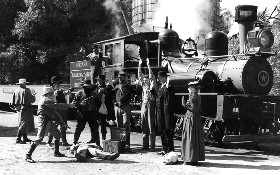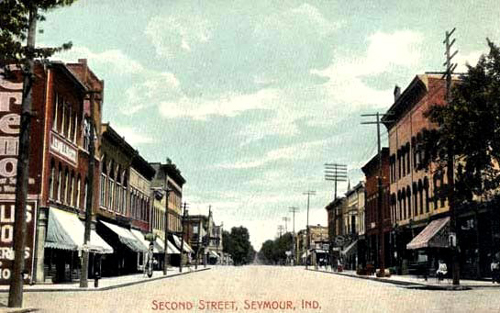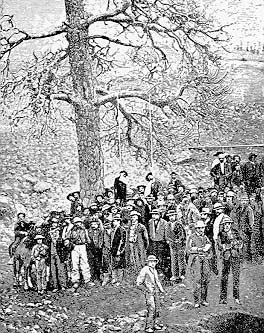
THEI EXCLUSIVE
The Reno Brothers Terrorize Seymour
Oct. 5, 2012
by Rick Osmon – THEI Web Manager/Writer
No, I’m not talking about the blood-sucking plant of the Little Shop of Horrors named Seymour. Although there may be a little bit of blood sucking associated with Seymour, Indiana as well.


John Mellencamp sings at Walter Reed Army Medical Center at a free performance for wounded warriors, family and staff April 27. About 200 wounded soldiers, staff and family members attended the event, providing a small but energetic crowd.
Date 27 April 2007, Wikimedia Commons.
After the end of the War Between the States (alternatively named the War of Northern Aggression), there was little work and nearly no prosperity in Seymour, Indiana, a town that had held many sympathizers for the Confederacy, and had even been home to a double handful of saboteurs and provocateurs who went out to aid John Hunt Morgan’s raid into Indiana. Another person of note that went forth to conquer from Seymour was John Mellencamp. His raids continue.
By early October of 1866, the local economy was in a dire state. The only business besides banks that was, to one extent or another, thriving was the railroads. Two rail lines crossed one another in Seymour, and both were doing fairly well. The North/South line, the Jeffersonville, Madison and Indianapolis Railroad, was built in the 1840s connecting Indianapolis to the Ohio River at Jeffersonville. It ran through the Shields farm at the area that is now Seymour. In 1852 when the East/West railroad, the Ohio and Mississippi Railroad, was going to be built, Capt. Meedy Shields who was the cousin of General John Tipton talked the surveyor, John Seymour, into putting it through his land. In return he named the town Seymour. All trains had to stop at a crossroad, making Seymour a bustling community and also making its railroad industry and associated travelers prime targets for criminals.
The Reno Brothers Gang, also known as the Reno Gang and The Jackson Thieves, were a group of criminals that operated in theMidwestern United States during and just after the American Civil War. Though short-lived, they carried out the first three peacetime train robberies in U.S. history. Most of the stolen money was never recovered.
The gang was broken with the lynchings of ten of its members by vigilante mobs in 1868. The murders created an international diplomatic incident with Canada and Great Britain, a general public uproar, and international newspaper coverage. No one was ever identified or prosecuted for the lynchings.
The Reno Gang was the first “Brotherhood of Outlaws” in the United States. They terrorized the Midwest for several years and inspired the creation of a host of other similar gangs who copied their crimes, leading to several decades of high-profile train robberies. Their gang attracted several new members after the end of the war. They started by robbing and murdering travelers in Jackson County and began to branch out to other counties, where they raided merchants and communities. They let headless bodies float down the East Fork of White River as a badge of their outlaw prowess.
They planned to rob their first train near Seymour; the town was an important rail hub at that time. No one had ever robbed a moving train before. On the evening of October 6, 1866, John Reno, Sim Reno, and Frank Sparkes boarded an Ohio and Mississippi Railway train as it started to leave the Seymour depot. They broke into the express car, restrained the guard, and broke open a safe containing approximately $16,000. From the moving train, the three men pushed a larger safe over the side, where the rest of the gang was waiting. Unable to open the second safe, the gang fled as a large posse approached.
Later, passenger George Kinney stepped forward to identify two of the robbers. The three men were arrested, but were released on bail. When Kinney was shot and killed, the other passengers refused to testify and all charges had to be dropped. However, the robbery would ultimately lead to the gang’s downfall. The contents of the safe were insured by the Adams Express Company, which hired the Pinkerton Detective Agency to track down and capture the gang.
It may indeed have been the Reno Brothers Gang who inspired the James Gang and several other outlaw bands to begin robbing trains. After the October 6th, 1866 robbery, a second, different armed group robbed the train on the same route. On September 28, 1867 a “copycat” holdup occurred at Seymour when another train was robbed. Authorities at first immediately suspected the Reno brothers, but later it was found that the train was robbed by Walker Hammond and Michael Colleran. Pulled off in the same manner as the Reno hold-up the previous year, the pair heisted about $8,000. Though Hammond and Colleran were “associates” of the Renos, John Reno tracked them down, beat them up, and turned then in, without the money, of course.
On November 17, 1867, the Daviess County Courthouse in Gallatin, Missouri was robbed. John Reno was identified, arrested by Pinkerton agents, and sentenced to 25 years in the Missouri State Penitentiary in 1868. (He was released in February 1878.) He returned to Seymour in 1886, but was again sent to prison, this time for counterfeiting, for three years.
However, this did not deter the gang. Three robberies in Iowa followed in quick succession, in February and March 1868. Frank Reno and fellow gang members Albert Perkins and Miles Ogle were caught by Pinkertons led by Allan Pinkerton‘s son William, but broke out of jail on April 1. A second train robbery occurred in December 1867, when two members of the gang robbed another train leaving the Seymour depot. The robbers netted $8,000, which was turned over to the brothers. A third train, owned by the Ohio & Mississippi, was stopped by six members of the gang on July 10, though the Reno brothers were not involved. Waiting in ambush however were ten Pinkerton agents. A shootout ensued; after several of the gang were wounded, the would-be robbers fled. Volney Elliott was captured and gave up information that led to the arrest of Charlie Roseberry and Theodore Clifton.
In March 1868, the residents of Seymour formed a vigilante group with the aim of killing the gang. In response, the gang fled west to Iowa where they robbed the Harrison County treasury of $14,000. The next day, they robbed Mills County treasury of $12,000. The Pinkerton detectives quickly located the men and arrested them at Council Bluffs, Iowa. On April 1, the gang escaped from their Iowa jail and returned to Indiana.
The Reno Gang then robbed its fourth train on May 22. Twelve men boarded a Jeffersonville, Madison and Indianapolis Railroad train as it stopped at the train depot in Marshfield, Indiana, a now defunct community in Scott County, Indiana. As the train pulled away, the gang overpowered the engineer and uncoupled the passenger cars, allowing the engine to speed away. After breaking into the express car and throwing express messenger Thomas Harkins off the train (causing fatal injuries), the gang broke open the safe, netting an estimated $96,000. This robbery gained national attention and was published in many major papers. The Pinkertons pursued, but the gang broke up and fled throughout the Midwest.
The gang attempted to rob another train on July 9. Pinkerton detectives had learned of the plan and ten agents were waiting aboard the train. When the gang broke in, the agents opened fire, wounding two of the gang. Everyone was able to escape except Volney Elliot, who identified the other members of the gang in exchange for leniency. Using the information, the detectives arrested two more members of the gang the next day in Rockport.
Lynchings
All three men were taken by train to jail. However, on July 10, 1868, three miles outside Seymour, Indiana, the prisoners were taken off the train, and hanged by the neck from a nearby tree, by a group of masked men calling itself the Jackson County Vigilance Committee. Three other gang members, Henry Jerrell, Frank Sparks, and John Moore, were captured shortly after in Illinois and returned to Seymour. In a grisly repeat, they too fell into the hands of vigilantes and were hanged from the same tree. The site became known as Hangman Crossing, Indiana.
On July 27, 1868, the Pinkertons captured William and Simeon Reno in Indianapolis. The men were jailed at the Scott County Jail in Lexington. They were tried and convicted of robbing the Marshfield train, but because of the threat of vigilantes, they were moved to the more secure Floyd County Jail. The day after their removal from Lexington, the vigilantes broke into the vacated jail, hoping to catch and lynch the men.
Frank Reno, the gang’s leader, and Charlie Anderson were tracked down to the Canadian border town of Windsor, Ontario. With the help of United States Secretary of State William H. Seward, the men were extradited in October under the provisions of the 1842 Webster-Ashburton Treaty. Both men were sent to New Albany to join the other prisoners.
On the night of December 11, about 65 hooded men traveled by train to New Albany. The men marched four abreast from the station to the Floyd County Jail where, just after midnight, the men forced their way into the jail and the sheriff’s home. After they beat the sheriff and shot him in the arm for refusing to turn over the keys, his wife surrendered them to the mob. Frank Reno was the first to be dragged from his cell to be lynched. He was followed by brothers William and Simeon. Another gang member, Charlie Anderson, was the fourth and last to be murdered, at around 4:30 a.m on December 12. It was rumored that the vigilantes were part of the group known as the Scarlet Mask Society or Jackson County Vigilance Committee. No one was ever charged, named or officially investigated in any of the lynchings. Many local newspapers, such as the New Albany Weekly Ledger, stated that “Judge Lynch” had spoken.
Frank Reno and Charlie Anderson were technically in federal custody when they were lynched. This is believed to be the only time in U.S. history that a federal prisoner had ever been lynched by a mob before a trial. Secretary of State Seward wrote a formal letter of apology as a result. A new bill was later introduced into the U.S. Congress that clarified the responsibility for the safety of extradited prisoners.
Note that nearly all the stolen money remains unrecovered. Either they had additional help, had conspired with someone else to move the booty, or there is a substantial treasure in silver coin awaiting a determined treasure hunter in southern Indiana. The Scott County train robbery alone would be worth close to $3 Million at scrap silver prices, discounting any additional collector value.
Go a little Deeper into Western Outlaw History
1/27/2012: The Jessie James Conspiracy (w/video
1/28/1220: Unsolved Mysteries: Were Billy the Kid, Brushy Bill Roberts one in the same? (2 videos)
~~~~~~~~~~~~~~~~~~~~~~~~~~~~~~~~~~~~~~~~~~~~~~~~~~~~~~~~
from youtube
EDITOR’S Extra Feature: First “Western” Movie Complete
The Great Train Robbery – 1903 Silent Film
Uploaded by Ella73TV2 on Dec 13, 2011
The Great Train Robbery – an action / western film. Film description from the Edison Films Catalogue, No. 200, Jan. 1904







I have been told my great great grandfather, Frank Thickston, was marshall of Seymour,IN during the Reno brothers time and had a run in with them. Do you have anything on marshall Thickston?
Hi Larry. The good marshal is, I think, mentioned in some of the accounts and documentaries. I’ll give my notes a once over and get back with you.